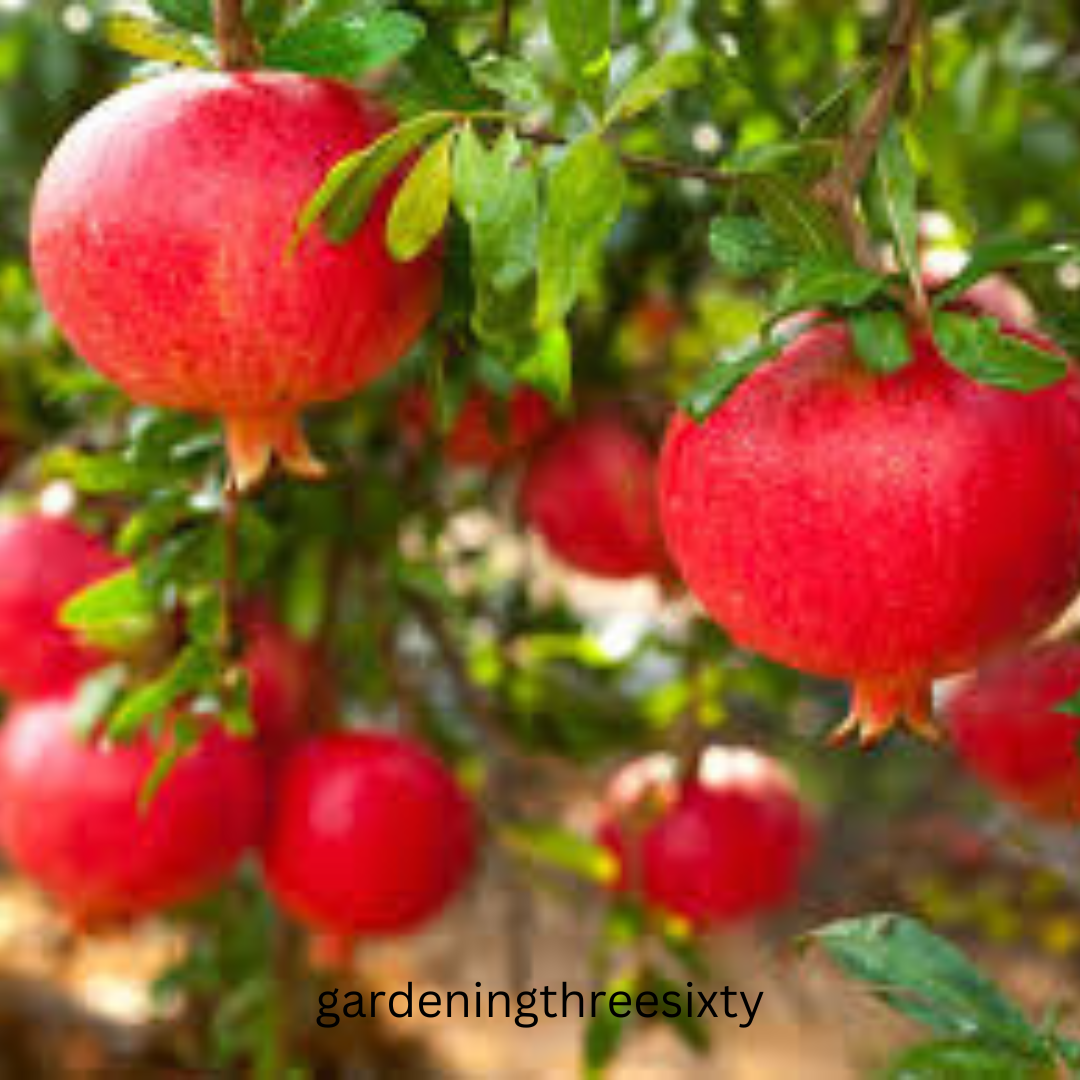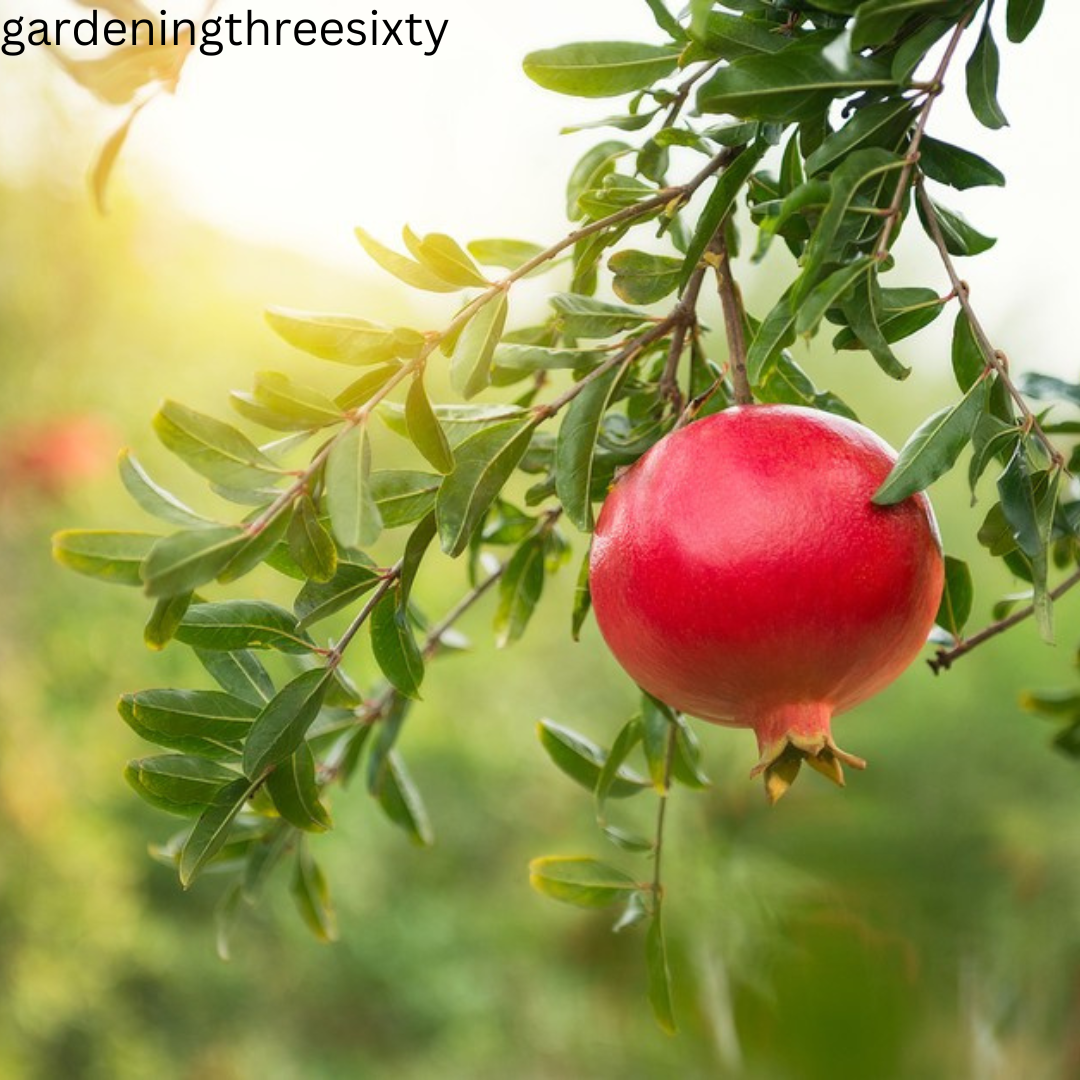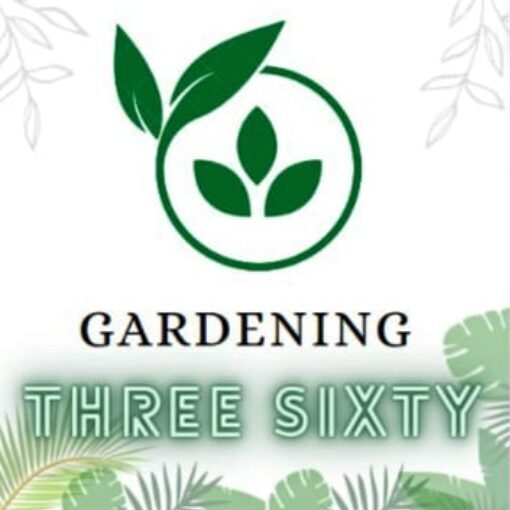Varieties of the Pomegranate tree, with its vibrant history and delicious fruit, is a true gem. Reaching up to 10 meters tall, it can be a shrub or a small tree, adorned with glossy green leaves. Fire-red flowers bloom before transforming into the namesake fruit – a round treasure with a tough, reddish rind.
Inside, arils, the jewel-toned, fleshy seeds, cling to a white membrane. Packed with antioxidants and vitamins, these arils are enjoyed fresh, juiced, or dried. Pomegranates thrive in warm climates, bringing beauty and bounty to gardens for centuries.
Overview of the Varieties of Pomegranate Tree Species
The pomegranate tree (Punica granatum) is a fruit-bearing deciduous shrub or small tree belonging to the Lythraceous family. Reaching heights of 16-33 feet tall, the pomegranate tree is known for its beautiful red flowers and namesake fruit.

Pomegranates are a rich source of vitamins and antioxidants, and the juice is a popular beverage in many cultures. The tree itself is drought-tolerant and can thrive in hot, dry climates, making it a valuable crop in many regions around the world.
Growth Characteristics for Varieties of Pomegranate Tree
The pomegranate tree is a sunshine sculptor. Reaching for warmth, it twists and turns, forming a statuesque silhouette with spiny branches. Unlike most fruit trees, it sheds its glossy green leaves in winter, standing bare until a fiery eruption of red blooms blankets its spring branches.
These blooms then morph into jewel-toned orbs, the iconic pomegranate, fattening with sunshine until fall’s harvest.
Flowering and Fruit Production for the Varietiesof Pomegranate Tree
A fiery crown! Pomegranates erupt with blooms in spring, a vibrant splash against emerald leaves. But these aren’t just for show. Early flowers turn into jewel-toned fruits, taking their time to plump up under the summer sun. By fall, the tree boasts orb-like treasures, each bursting with ruby red arils, a sweet reward for patient care.
Adaptability and Cultivation for the Varieties of Pomegranate Tree
The pomegranate thrives like a desert nomad. Its deep roots seek out hidden water, while its leathery leaves minimize sun scorch. This resilience lets it flourish in hot, dry regions like the Mediterranean and parts of Asia.
Cultivation mirrors this simplicity. Well-draining soil, infrequent watering, and plenty of summer sun are key. With minimal care, the pomegranate rewards you with jewel-toned fruits bursting with antioxidants.
Importance in Various Cultures and Traditions for the Varieties of Pomegranate Tree
The pomegranate tree holds significance across cultures and traditions. Its jewel-toned fruit symbolizes fertility, abundance, and even immortality in some beliefs. In Greek mythology, pomegranates represent Persephone’s connection to the underworld.
while ancient Egyptians included them in their burial rituals. Across Asia, pomegranates represent prosperity and good luck, often used in religious ceremonies. Even today, the vibrant fruit is a popular decorative motif and a symbol of health due to its antioxidant properties. Historical Significance and Cultural Importance of Pomegranate Tree
The pomegranate tree boasts a rich history and deep cultural significance across many civilizations. Cultivated for millennia, its origins likely trace back to Iran and Afghanistan. The fruit itself, with its abundant seeds, has symbolized fertility and abundance.
In Greek mythology, pomegranates were linked to Persephone, queen of the underworld, and consumption was tied to rebirth and the cycle of seasons. Similarly, pomegranates appear in various religious texts, including the Bible and Quran, often associated with eternal life or paradise.
Beyond symbolism, pomegranates were valued for their medicinal properties and vibrant beauty, making them a versatile and meaningful tree throughout history.

Pomegranate and Ancient Civilization for the Varieties of Pomegranate Tree
Pomegranates were rockstars of the ancient world. Cultivated around 5,000 years ago in Mesopotamia, they spread like wildfire throughout Asia and the Mediterranean. Egyptians saw them as symbols of life after death, while Greeks linked them to love and fertility.
Across the board, pomegranates were prized for their juicy flesh, refreshing qualities, and abundance of seeds, representing prosperity. They weren’t just delicious; their rinds and roots were used medicinally, and their image adorned clothing, jewelry, and art. From royalty to commoners, pomegranates were a vibrant part of ancient life.
Popular Varieties of Pomegranate Trees
Pomegranate trees come in a delightful array, each offering unique flavors and characteristics. Here are some popular varieties to consider
Ruby Red Varieties of Pomegranate Tree
The jewel-toned crown atop a ruby-red pomegranate hints at the vibrant treasure within. Its ruddy skin, taut and smooth, promises a burst of flavor. Though not technically a ruby, the arils, nestled in a sea of white, glimmer with a captivating crimson.
Each tiny seed capsule holds a juicy explosion, waiting to tantalize the taste buds with a sweet and tart dance. This antioxidant powerhouse isn’t just delicious, it’s a symbol of abundance and health.
Wonderful varieties of Pomegranate Tree
The pomegranate, a jewel-toned orb cradled by autumn branches, holds a treasure within. Its ruddy crown conceals a labyrinth of compartments, each bursting with ruby-red arils. These glistening seeds, cradled in soft, white flesh, offer a burst of sweet and tart flavor, a delightful contrast to the fruit’s leathery rind.
Native to a swathe of land stretching from Iran to India, the pomegranate has traveled the world, gracing tables and adorning myths for millennia. Prized for its vibrant beauty and potential health benefits, this fruit has become a symbol of abundance, fertility, and regeneration.
Haku Botan varieties of Pomegranate Tree
The Haku Botan, a unique jewel from Japan, isn’t your average pomegranate. This multi-talented shrub stuns with a cascade of creamy double blooms throughout summer, transforming your garden into a haven of elegance. But its beauty extends beyond flowers. Come fall, the Haku Botan surprises with green-yellow fruits, a delightful contrast to the typical ruby red. Inside, discover a treasure trove of white arils, boasting a flavor that’s light on acidity and perfect for refreshing juices.
This cold-hardy wonder thrives in cooler climates, making it a dream come true for pomegranate enthusiasts in regions where other varieties struggle. Not only will it grace your landscape with its charm, but it’ll also reward you with delicious, low-acid fruit – a true testament to the Haku Botan’s magic.

Dwarf Varieties of Pomegranate Tree
There’s just one widely recognized dwarf pomegranate variety, known as Punica granatum ‘Nana’. This dwarf shrub reaches around 3 feet tall and wide, making it perfect for containers or small gardens.
It produces beautiful orange-red flowers that bloom in early summer, followed by small, decorative fruits in the fall. These fruits are edible but tend to be more tart than those of full-sized pomegranate trees.
Benefits and Considerations for Growing Dwarf Varieties of Pomegranate Tree
Dreaming of homegrown pomegranates but are tight on space? Dwarf pomegranate trees offer a delightful solution. These compact cousins of their full-sized kin pack a punch with vibrant blooms, delicious fruit, and a manageable size ideal for patios, containers, or even bonsai enthusiasts.
On the plus side, dwarf pomegranates flower profusely at a young age, treating you to a dazzling display and the potential for homegrown fruits. Their smaller stature makes them perfect for balconies and sunny alcoves, adding a touch of the exotic to your surroundings. Plus, many dwarf varieties are surprisingly cold-tolerant, extending their appeal to gardeners in cooler climates.
But before you rush out and grab one, consider their needs. Dwarf pomegranates thrive in full sun and well-draining soil. They’ll need regular watering, especially during fruiting, and might require occasional pruning to maintain their shape. Also, while some dwarf varieties are self-pollinating, others may need a hand from you or helpful pollinators to set fruit.
So, if you have the space and can provide the sunshine and care, dwarf pomegranates can be a rewarding addition to your garden, offering a taste of the Mediterranean right on your doorstep.
Sweet vs. Tart Pomegranate Varieties of Pomegranate Tree
Pomegranates come in a surprising range of flavors, from sweet to tart! If you prefer a candy-like taste, seek out the “Ever sweet” variety. Its arils (seeds) are bursting with sweetness and have minimal tartness. Another very sweet option is the “Desertic,” known for its smaller size and soft seeds.
For a more balanced flavor profile, varieties like “Wonderful” (the most common type in stores) or “Parfianka” are great choices. They offer a delightful blend of sweetness and tartness. If you enjoy a more prominent tart note, consider the “Salavatski” or “Al Sirin Nar.” These varieties are known for their vibrant acidity alongside their sweetness.
Ultimately, the best pomegranate for you depends on your taste preference! Whether you crave pure sweetness or a delightful balance with a touch of tartness, there’s a perfect pomegranate variety waiting to be discovered.

Early Season Pomegranate Varieties of Pomegranate Tree
Pomegranate season might seem far off, but some varieties ripen earlier than others! If you’re looking to enjoy these delicious fruits sooner, consider planting an early-season variety. Two popular choices are Emek and Acco.
Emek boasts a beautiful crown and ripens around early August, while Acco is known for its low acidity, good taste, and vibrant red color inside and out, typically ready by mid-August. These are just a couple of options – with some research, you can find the perfect early-season pomegranate to add a touch of summer magic to your harvest.
Late Season Pomegranate Varieties of Pomegranate Tree
Pomegranate varieties with a late harvest season tend to thrive in areas with long, hot summers. These varieties ripen, often reaching peak flavor in late fall or even winter. The most famous example is likely ‘Wonderful,’ known for its high acidity and deep red arils.
However, there are other options for the patient gardener. Breeders are constantly developing new cultivars, so staying informed about the latest offerings can be beneficial. If you’re looking for a late-season variety, remember that these pomegranates may require specific climate conditions to mature and fully achieve optimal sweetness.
Cold-Hardy Pomegranate Varieties of Pomegranate Tree
Pomegranates are delicious fruits native to the Middle East and Central Asia. They’re not typically known for being cold-hardy, but there are a few varieties that can tolerate colder temperatures, even down to around 0 degrees Fahrenheit. These pomegranate varieties are perfect for gardeners in colder climates who want to try growing their own pomegranates.
Here are two of the most popular cold-hardy pomegranate varieties:
Salavatski Varieties of Pomegranate Tree
This variety is one of the most reliable and cold-hardy pomegranates available. It produces medium-large pale red fruit with red arils and delicious sweet-tart juice. Salavatski is cold-hardy to about 5 degrees Fahrenheit, making it suitable for zones 7b and higher.
Russian 26 Varieties of Pomegranate Tree
The Russian 26 pomegranate was discovered in southern Russia in the mid-1900s. It’s believed to be one of the hardiest pomegranate varieties, tolerating temperatures down to 0 degrees Fahrenheit. This variety grows into a large shrub or small tree, reaching up to 10 feet tall and wide. It produces red pomegranates with sweet and juicy arils.
Heat-Tolerant Pomegranate Varieties of Pomegranate Tree
Pomegranate trees are a great option for hot and dry climates. They’re native to the Mediterranean region, which has similar conditions to many warm areas around the world. Here are two heat-tolerant pomegranate varieties:
Wonderful varieties of Pomegranate Tree
This is a popular commercial variety that’s known for its large, juicy fruits. It’s well-adapted to hot climates and can handle long periods of drought.
Parfiyan varieties of Pomegranate Tree
This variety is known for its early ripening fruit and its resistance to sunburn. It’s a good choice for growers in areas with very hot summers.
Both of these varieties are self-pollinating, so you only need one tree to get fruit. They’re also relatively low-maintenance trees that are easy to care for. With a little care, you can enjoy the delicious fruits of your pomegranate tree for many years to come.

Choosing the Right Pomegranate Varieties for Your Garden
Pomegranates are a beautiful and rewarding addition to any garden, but with so many varieties available, choosing the right one can be tricky. Consider your climate, taste preferences, and desired use for the fruit.
For hot, dry regions, classic choices like Wonderful or Alcoche thrive. If you have a shorter growing season, look for early varieties like Eversweet or Sweet. Container gardeners can enjoy dwarf options like Red Silk or Nana, though the latter’s fruit is mainly ornamental.
Flavor profiles vary too. Tart favorites include Granada and Parfianka, while Angel Red and Ako lean towards the sweeter side. Some varieties boast soft, juicy arils ideal for fresh eating (Wonderful), while others have firmer arils better suited for juicing (Parfianka).
No matter your preference, there’s a perfect pomegranate out there. With a little research, you’ll be enjoying this delicious and versatile fruit from your own garden for years to come.
Have a glace for more information
Pomegranates in Different Cultures and Mythologies
The humble pomegranate boasts a rich history that transcends cultures and mythologies. In ancient Greece, it held a dual meaning: the “fruit of the dead” linked to Hades and the underworld, but also a symbol of fertility associated with love goddesses like Aphrodite. The myth of Persephone consuming pomegranate seeds tied her to the underworld for part of the year, explaining the changing seasons.
Moving to the Middle East, pomegranates were seen as emblems of abundance and prosperity. Iranian cultures revered them in religious rituals, with the Zoroastrian faith finding favor and blessings symbolized by the fruit. Some even believed pomegranates, not apples, were the forbidden fruit of Eden.
Across the Mediterranean, pomegranates continued to hold significance. In some regions, smashing a pomegranate on New Year’s Eve signifies good luck and abundance for the coming year. They’re also offered during weddings and childbirth ceremonies, reflecting a deep connection to fertility and new beginnings.
Beyond the Mediterranean, pomegranates hold meaning in Asia as well. India sees them as symbols of life and vitality, often depicted in art and offered during auspicious occasions. In China, they represent immortality and resurrection.
So next time you bite into a pomegranate, remember you’re not just enjoying a delicious fruit, but one steeped in symbolism and stories that have captivated cultures for millennia.
Conclusion
The fate of the pomegranate tree depends on the context. In mythology and literature, it can symbolize fertility, rebirth, or even deception. Perhaps the tree thrives, its branches heavy with ruby-red fruit, a testament to life and abundance. Or maybe it withers, its once vibrant leaves turning brown, reflecting loss or the passage of time.
In a historical context, the tree could stand as a silent witness to a bygone era. Imagine a once-grand palace, its gardens overgrown, the lone pomegranate a reminder of happier days. Or perhaps the tree marks a turning point, its presence woven into the narrative of a historical event.
Even in a more scientific context, the conclusion holds intrigue. Has a botanist successfully cultivated a rare pomegranate variety? Or did a blight ravage the orchard, leaving the tree a cautionary tale?
The possibilities are as vast as the imagination. The pomegranate tree’s ending hinges on the story you want to tell.
Frequently Asked Questions
What is the best variety of pomegranate trees?
There isn’t a single “best” variety of pomegranate since it depends on what you’re looking for in a tree. Here are some popular choices to consider, each with its own strengths. Wonderful, Parfianka, Angel Red, etc.
Which country’s pomegranate is best?
It’s difficult to say definitively which country has the “best” pomegranate, as taste can be subjective. However, some contenders are well-known for their quality. But Iran and Afghanistan are most famous for pomegranate.
What is the new variety of pomegranate?
A relatively new variety of pomegranates is the CAZri Vishal, which was released by India’s Central Arid Zone Research Institute (CAZRI) in 2020. This variety is a cross between the Ganesh and Khog varieties
Who is the world’s largest producer of pomegranates?
India and China are the leading producers globally for pomegranates
What is the best pomegranate variety for juice?
Two of the most popular pomegranate varieties for juicing are wonderful and Parfianka.
For Further Knowledge
- Guava Seed Germination
- How To Grow an Orange Tree From an Orange
- Healthy Fruits that Grow on Vines
- How to Grow Best Cold Hardy Avocado Trees
- Evergreen fruit trees
- Hanging Baskets
- Companion Planting for Spinach
- Florida Native Palm Trees
- How do weeds grow
- Trees with Yellow Leaves
- Guideline for Best Grass Seed for Florida
- Christmas Jewel Holly
- Baby Jade Boxwood
